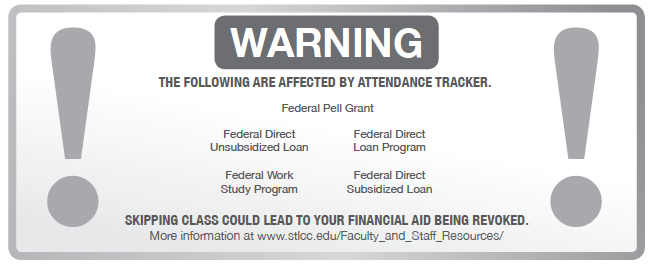Banner XE Attendance Tracking system replaces paper attendance ‘green sheets’
By: SPENCER GLEASON
Editor-in-Chief

In order to assist STLCC with fulfilling the federal regulations for recording and reporting attendance, the college instituted the Banner XE Attendance Tracking system at the beginning of the fall 2013 semester. The attendance tracker has become the electric version of “green sheets” or the paper form of how attendance was previously taken.
The program directly affects students with financial aid, according to Regina Blackshear, Director of District Wide Financial Aid and Scholarships. The financial aid office uses the module to assess when and how to distribute federal money.
“It helps the school, but it also helps the student,” Blackshear said. “When you have a student that has paid for a class, but never attended we have to send that money back to the Department of Education. We’re liable. The student is in the situation, now, where they have to pay the institution back.”
According to Blackshear, the program was put in place because the college had some issues where attendance was not reported for students until the fifth week of class. The Department of Education determined that a student missing 14 consecutive calendar days of class was the magic number of excessive absences and the school needed a quicker way to evaluate attendance.
“That meant then, if you received financial aid and you had not attended class, that put us in a lot of positions where we were actually sending money back [to the government], taking money away and those types of issues.” Blackshear said. “The green sheets were not doing it anymore.”
Blackshear, who has been in her position at STLCC for two years, said she hopes that in using this system, they can have real attendance data to work with.
“We can actually start looking at processes that will allow us to have attendance on the first week of class,” Blackshear said. “Then hopefully we can look at moving the refund dates back up closer to the beginning of the semester because then we have attendance to confirm.”
According to Interim Vice President of Student Affairs Kim Fitzgerald, professors can still use green sheets for their daily attendance, but once-a-week need to enter the attendance records online.
“They can still do that and then go in and do it electronically. Once-a-week is ideal because those first couple weeks they have to really stay on it,” Fitzgerald said. “It’s not like a daily task. They can do it by hand and then go in on the computer and do it later.”
The attendance tracker is designed to track each individual class session, but lies within a 14 consecutive calendar day period.
For students who take one class on Monday, Wednesday, Friday and a different class on Tuesday, Thursday, not attending the class on Tuesday, Thursday, for the two-week time frame, throws up a red flag even though it is only four class periods.
The Department of Education also requires proof of attendance in online courses. Just logging in the class does not count as attending, according to the Faculty and Staff Resources section on the STLCC website. There must be verification of regular interaction between students and faculty, such as contributing to an online discussion. For this reason, the STLCC website says the school has made it mandatory that all online courses are required to document a weekly assignment.
However, according to Blackshear, if a student misses just the one week of classes (or two consecutive class days of a Tuesday, Thursday class) and then comes the second week, the 14-day period starts over.
“It’s 14 consecutive,” Blackshear said. “If a student misses 10 days and then shows back up, the clock starts all the way back over.”
At the 10-day mark, STLCC sends out two emails, one to the instructor and the other to the student.
“The one to the instructor says that this student has been reported as not being in your class for 10 days. Is that accurate?” Blackshear said. “The one to the student says, ‘You haven’t been to class in the last 10 days. Are you attending or not attending?’ If they are, it gives them an opportunity to talk to the instructor. The email will also tell them if they’re not intending on coming back, then there is a withdrawal process that they need to do. If they don’t do that, then by the end of the semester, they’ll have an ‘F.’”
Federal regulations expect the college to determine whether or not the student has the intention of returning to class or withdrawing, said Blackshear. In order for STLCC to identify students who have excessive absences, without administratively withdrawing the student, STLCC created the code for registered but not attending (RN).
“Students who have been given an RN status will be documented as just not attending. That allows for if there is some reason a mistake was made, as far as the attendance, the instructor can fix that,” Blackshear said. “It also allows if for some reason a student shows up after those 14 days and does enough work to still pass, it allows the instructor to still give that student a passing grade if that’s what they deserve.”
According to Blackshear, students should be proactive about their situation if they know that they are going to miss class.
“What that is saying is the student has made contact. We know where the student is and the student has the intention of coming back,” Blackshear said. “Then when we send out an email it’ll say, ‘We’re getting ready to say you’re registered, but not attending. Is this accurate?’ We want to give them some time in case they’re not proactive to say, ‘Wait. I need to contact my instructor.’”
Like any new product, Blackshear said that there were some issues last semester. The problems that arose according to Blackshear mainly involved students who had been given an RN status.
“I wish I could tell you it was wonderful. But I can tell you that this semester has gone by a lot smoother,” Blackshear said. “There were some issues for students with an RN status. There’s an option for the instructor to update the attendance. They may have accidentally marked students there when the student knew they’ve never been there. What we do then, is we send out an email that says, ‘You’re sure this student hasn’t been there? Are you sure she’s come back?’ That gives the instructor the opportunity to go in and take that date out. We’re still getting used to working the program out itself.”
Despite the kinks, according to Blackshear, the attendance tracker has helped STLCC save money.
“If a student has been reported as never attending a class, then they never received the financial aid for that class. That’s one of the mechanisms that will help us to get that refund date moved up,” Blackshear said. “Because if I register for 12 hours and I’ve truly only gone to six, then financial aid should only release aid for six hours. And that’s gone really well.”










